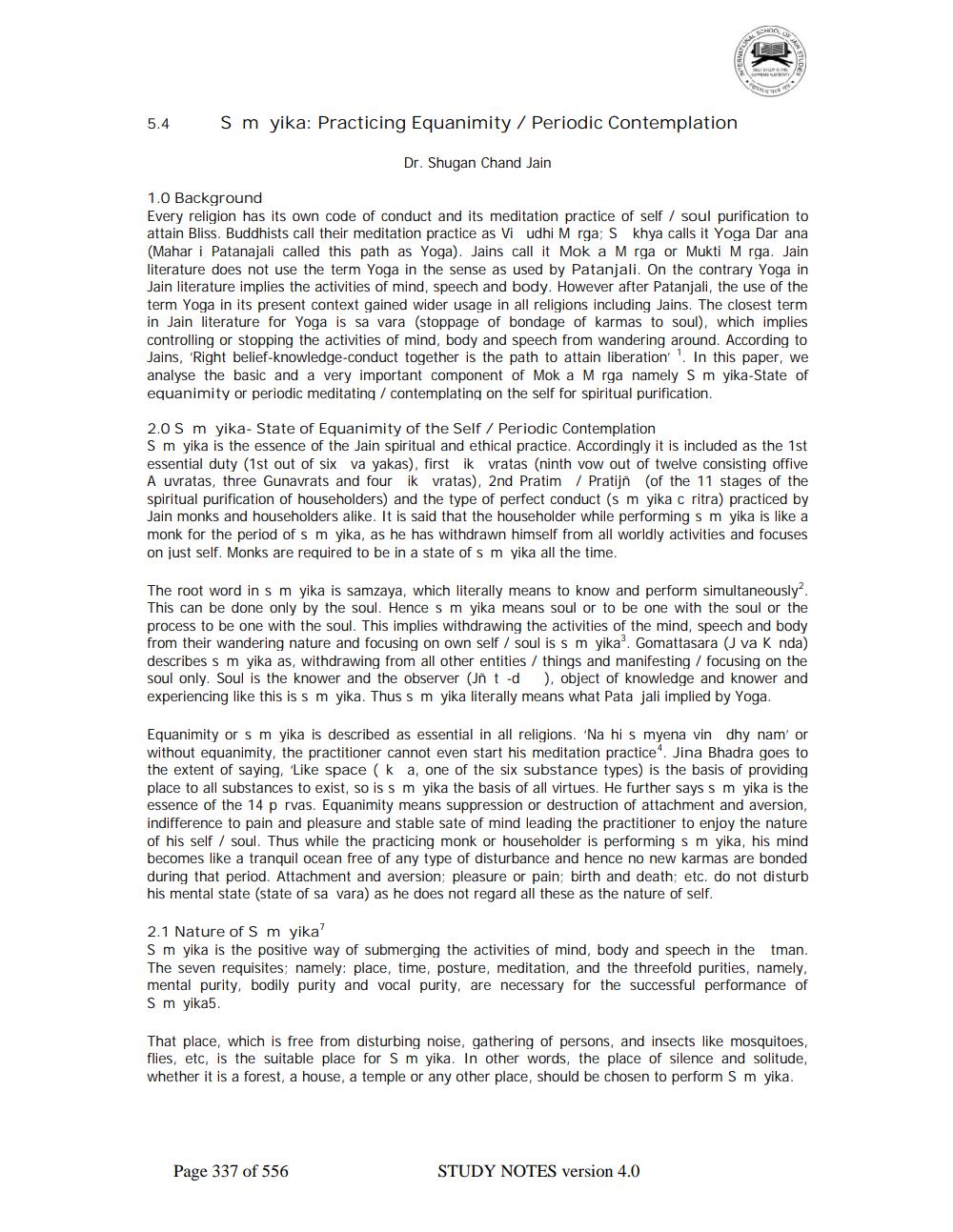________________
5.4
Sm yika: Practicing Equanimity / Periodic Contemplation
Dr. Shugan Chand Jain
1.0 Background Every religion has its own code of conduct and its meditation practice of self / soul purification to attain Bliss. Buddhists call their meditation practice as Viudhi Mrga; S khya calls it Yoga Dar ana (Mahar i Patanajali called this path as Yoga). Jains call it Mok a Mrga or Mukti Mrga. Jain literature does not use the term Yoga in the sense as used by Patanjali. On the contrary Yoga in Jain literature implies the activities of mind, speech and body. However after Patanjali, the use of the term Yoga in its present context gained wider usage in all religions including Jains. The closest term in Jain literature for Yoga is sa vara (stoppage of bondage of karmas to soul), which implies controlling or stopping the activities of mind, body and speech from wandering around. According to Jains, 'Right belief-knowledge-conduct together is the path to attain liberation ! In this paper, we analyse the basic and a very important component of Mok a Mrga namely Sm yika-State of equanimity or periodic meditating / contemplating on the self for spiritual purification.
2.0 S m yika- State of Equanimity of the Self / Periodic Contemplation S m yika is the essence of the Jain spiritual and ethical practice. Accordingly it is included as the 1st essential duty (1st out of six va yakas), first ik vratas (ninth vow out of twelve consisting offive A uvratas, three Gunavrats and four ik vratas), 2nd Pratim / Pratijn (of the 11 stages of the spiritual purification of householders) and the type of perfect conduct (s m yika c ritra) practiced by Jain monks and householders alike. It is said that the householder while performing s m yika is like a monk for the period of s m yika, as he has withdrawn himself from all worldly activities and focuses on just self. Monks are required to be in a state of s m yika all the time.
The root word in s m yika is samzaya, which literally means to know and perform simultaneously? This can be done only by the soul. Hence s m yika means soul or to be one with the soul or the process to be one with the soul. This implies withdrawing the activities of the mind, speech and body from their wandering nature and focusing on own self / soul is s m yika'. Gomattasara (J va k nda) describes s m yika as, withdrawing from all other entities / things and manifesting / focusing on the soul only. Soul is the knower and the observer (In t .d . object of knowledge and knower and experiencing like this is s m yika. Thus s m yika literally means what Pata jali implied by Yoga.
Equanimity or sm yika is described as essential in all religions. 'Na hi s myena vin dhy nam' or without equanimity, the practitioner cannot even start his meditation practice. Jina Bhadra goes to the extent of saying, 'Like space (k a, one of the six substance types) is the basis of providing place to all substances to exist, so is s m yika the basis of all virtues. He further says s m yika is the essence of the 14 p rvas. Equanimity means suppression or destruction of attachment and aversion, indifference to pain and pleasure and stable sate of mind leading the practitioner to enjoy the nature of his self / soul. Thus while the practicing monk or householder is performing s m yika, his mind becomes like a tranquil ocean free of any type of disturbance and hence no new karmas are bonded during that period. Attachment and aversion; pleasure or pain; birth and death; etc. do not disturb his mental state state of sa vara) as he does not regard all these as the nature of self.
2.1 Nature of S m yika? Sm yika is the positive way of submerging the activities of mind, body and speech in the tman. The seven requisites; namely: place, time, posture, meditation, and the threefold purities, namely, mental purity, bodily purity and vocal purity, are necessary for the successful performance of Sm yika5.
That place, which is free from disturbing noise, gathering of persons, and insects like mosquitoes flies, etc, is the suitable place for S m yika. In other words, the place of silence and solitude, whether it is a forest, a house, a temple or any other place, should be chosen to perform S m yika.
Page 337 of 556
STUDY NOTES version 4.0




